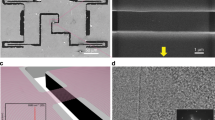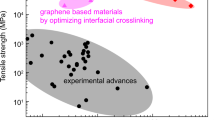Abstracct
Efforts to obtain high-strength graphene sheets by near-room-temperature assembly have been frustrated by the misalignment of graphene layers, which degrades mechanical properties. While in-plane stretching can decrease this misalignment, it reappears when releasing the stretch. Here we use covalent and π–π inter-platelet bridging to permanently freeze stretch-induced alignment of graphene sheets, and thereby increase isotropic in-plane sheet strength to 1.55 GPa, in combination with a high Young’s modulus, electrical conductivity and weight-normalized shielding efficiency. Moreover, the stretch-bridged graphene sheets are scalable and can be easily bonded together using a commercial resin without appreciably decreasing the performance, which establishes the potential for practical applications.
This is a preview of subscription content, access via your institution
Access options
Access Nature and 54 other Nature Portfolio journals
Get Nature+, our best-value online-access subscription
$29.99 / 30 days
cancel any time
Subscribe to this journal
Receive 12 print issues and online access
$259.00 per year
only $21.58 per issue
Buy this article
- Purchase on Springer Link
- Instant access to full article PDF
Prices may be subject to local taxes which are calculated during checkout





Similar content being viewed by others
Data availability
The data that support the findings of this study are available from the corresponding author upon reasonable request.
References
Lee, C., Wei, X., Kysar, J. W. & Hone, J. Measurement of the elastic properties and intrinsic strength of monolayer graphene. Science 321, 385–388 (2008).
Mao, L. et al. Stiffening of graphene oxide films by soft porous sheets. Nat. Commun. 10, 3677 (2019).
Xu, Z. et al. Ultrastiff and strong graphene fibers via full-scale synergetic defect engineering. Adv. Mater. 28, 6449–6456 (2016).
Xin, G. et al. Microfluidics-enabled orientation and microstructure control of macroscopic graphene fibres. Nat. Nanotechnol. 14, 168–175 (2019).
Zhong, J. et al. Efficient and scalable synthesis of highly aligned and compact two-dimensional nanosheet films with record performances. Nat. Commun. 9, 3484 (2018).
Wan, S. & Cheng, Q. Fatigue-resistant bioinspired graphene-based nanocomposites. Adv. Funct. Mater. 27, 1703459 (2017).
Wan, S., Peng, J., Jiang, L. & Cheng, Q. Bioinspired graphene-based nanocomposites and their application in flexible energy devices. Adv. Mater. 28, 7862–7898 (2016).
Dai, L. Functionalization of graphene for efficient energy conversion and storage. Acc. Chem. Res. 46, 31–42 (2013).
Cruz-Silva, R., Endo, M. & Terrones, M. Graphene oxide films, fibers, and membranes. Nanotechnol. Rev. 5, 377–391 (2016).
Ye, M., Zhang, Z., Zhao, Y. & Qu, L. Graphene platforms for smart energy generation and storage. Joule 2, 245–268 (2018).
Yu, X. et al. Graphene-based smart materials. Nat. Rev. Mater. 2, 17046 (2017).
Hu, K. et al. Written-in conductive patterns on robust graphene oxide biopaper by electrochemical microstamping. Angew. Chem. Int. Ed. 52, 13784–13788 (2013).
Park, S. et al. Graphene oxide papers modified by divalent ions-enhancing mechanical properties via chemical cross-linking. ACS Nano 2, 572–578 (2008).
Yeh, C. N., Raidongia, K., Shao, J., Yang, Q. H. & Huang, J. On the origin of the stability of graphene oxide membranes in water. Nat. Chem. 7, 166–170 (2014).
An, Z., Compton, O. C., Putz, K. W., Brinson, L. C. & Nguyen, S. T. Bio-inspired borate cross-linking in ultra-stiff graphene oxide thin films. Adv. Mater. 23, 3842–3846 (2011).
Xu, Y., Bai, H., Lu, G., Li, C. & Shi, G. Flexible graphene films via the filtration of water-soluble noncovalent functionalized graphene sheets. J. Am. Chem. Soc. 130, 5856–5857 (2008).
Wan, S. et al. Ultrastrong graphene films via long-chain π-bridging. Matter 1, 389–401 (2019).
Wan, S. et al. Sequentially bridged graphene sheets with high strength, toughness, and electrical conductivity. Proc. Natl Acad. Sci. USA 115, 5359–5364 (2018).
Gong, T. et al. Thickness dependence of the mechanical properties of free-standing graphene oxide papers. Adv. Funct. Mater. 25, 3756–3763 (2015).
Pei, S., Zhao, J., Du, J., Ren, W. & Cheng, H.-M. Direct reduction of graphene oxide films into highly conductive and flexible graphene films by hydrohalic acids. Carbon 48, 4466–4474 (2010).
Barentsen, H. M., van Dijk, M., Kimkes, P., Zuilhof, H. & Sudhölter, E. J. R. Dye-substituted acetylenes and diacetylenes: convenient polymerization as studied by differential scanning calorimetry, FT-IR, and UV-vis spectroscopy. Macromolecules 32, 1753–1762 (1999).
Melveger, A. J. & Baughman, R. H. Raman spectral changes during the solid-state polymerization of diacetylenes. J. Polym. Sci. Polym. Phys. Ed. 11, 603–619 (1973).
Chen, I. W. P. Noncovalently functionalized highly conducting carbon nanotube films with enhanced doping stability via an amide linkage. Chem. Commun. 49, 2753–2755 (2013).
Cheng, Q. F., Wu, M., Li, M., Jiang, L. & Tang, Z. Ultratough artificial nacre based on conjugated cross-linked graphene oxide. Angew. Chem. Int. Ed. 52, 3750–3755 (2013).
Wan, S., Fang, S., Jiang, L., Cheng, Q. & Baughman, R. H. Strong, conductive, foldable graphene sheets by sequential ionic and π bridging. Adv. Mater. 30, 1802733 (2018).
Wan, S., Jiang, L. & Cheng, Q. Design principles of high-performance graphene films: interfaces and alignment. Matter 3, 696–707 (2020).
Wan, S. & Cheng, Q. Role of interface interactions in the construction of GO-based artificial nacres. Adv. Mater. Interfaces 5, 1800107 (2018).
Shen, B., Zhai, W. & Zheng, W. Ultrathin flexible graphene film: an excellent thermal conducting material with efficient EMI shielding. Adv. Funct. Mater. 24, 4542–4548 (2014).
Kumar, P. et al. Large-area reduced graphene oxide thin film with excellent thermal conductivity and electromagnetic interference shielding effectiveness. Carbon 94, 494–500 (2015).
Shahzad, F. et al. Electromagnetic interference shielding with 2D transition metal carbides (MXenes). Science 353, 1137–1140 (2016).
Wan, S. et al. Strong sequentially bridged MXene sheets. Proc. Natl Acad. Sci. USA 117, 27154–27161 (2020).
Zhou, T. et al. Second time-scale synthesis of high-quality graphite films by quenching for effective electromagnetic interference shielding. ACS Nano 14, 3121–3128 (2020).
Xi, J. et al. Graphene aerogel films with expansion enhancement effect of high-performance electromagnetic interference shielding. Carbon 135, 44–51 (2018).
Liu, J. et al. Hydrophobic, flexible, and lightweight MXene foams for high-performance electromagnetic-interference shielding. Adv. Mater. 29, 1702367 (2017).
Zeng, Z. et al. Nanocellulose-MXene biomimetic aerogels with orientation-tunable electromagnetic interference shielding performance. Adv. Sci. 7, 2000979 (2020).
Liu, Y., Xie, B., Zhang, Z., Zheng, Q. & Xu, Z. Mechanical properties of graphene papers. J. Mech. Phys. Solids 60, 591–605 (2012).
Zhu, J. et al. Pseudonegative thermal expansion and the state of water in graphene oxide layered assemblies. ACS Nano 6, 8357–8365 (2012).
Yang, M. et al. Interlayer crosslinking to conquer the stress relaxation of graphene laminated materials. Mater. Horiz. 5, 1112–1119 (2018).
Cheng, Q. et al. High mechanical performance composite conductor: multi-walled carbon nanotube sheet/bismaleimide nanocomposites. Adv. Funct. Mater. 19, 3219–3225 (2009).
Eigler, S. et al. Wet chemical synthesis of graphene. Adv. Mater. 25, 3583–3587 (2013).
Marcano, D. C. et al. Improved synthesis of graphene oxide. ACS Nano 4, 4806–4814 (2010).
Acknowledgements
This work was supported by the Excellent Young Scientist Foundation of NSFC (grant no. 51522301), the National Natural Science Foundation of China (grant nos 22075009, 51961130388, 21875010, 51103004 and 52003011), Newton Advanced Fellowship (grant no. NAF\R1\191235), Beijing Natural Science Foundation (JQ19006), the National Postdoctoral Programme for Innovative Talents (BX20200038), the China Postdoctoral Science Foundation (2019M660387), the 111 Project (B14009), the Postdoctoral Research Program on Innovative Practice in Jiangmen and Excellent Sino-Foreign Young Scientist Exchange Program of CAST. Support at the University of Texas at Dallas was provided by the Air Force Office of Scientific Research grant no. FA9550-18-1-0510, the Robert A. Welch Foundation grant no. AT-0029 and National Science Award no. CMMI-1636306. We thank the High Performance Computing Platform at Beihang University for help with some simulation experiments.
Author information
Authors and Affiliations
Contributions
Q.C. supervised the project and Q.C. and R.H.B. conceived it. S. Wan performed the experiments and characterizations. S. Wang and Z.X. carried out the MD simulations and theoretical analysis. S. Wan and Y.C. carried out in situ Raman testing and analysed the data. S. Wan, Y.C., S.F., L.J., R.H.B. and Q.C. cowrote the manuscript. All authors discussed the results and commented on the manuscript.
Corresponding authors
Ethics declarations
Competing interests
The authors declare no competing interests.
Additional information
Peer review information Nature Materials thanks Jie Lian and the other, anonymous, reviewer(s) for their contribution to the peer review of this work.
Publisher’s note Springer Nature remains neutral with regard to jurisdictional claims in published maps and institutional affiliations.
Supplementary information
Supplementary Information
Supplementary Methods, Notes 1–7, Figs. 1–32, Tables 1–12 and references.
Rights and permissions
About this article
Cite this article
Wan, S., Chen, Y., Fang, S. et al. High-strength scalable graphene sheets by freezing stretch-induced alignment. Nat. Mater. 20, 624–631 (2021). https://doi.org/10.1038/s41563-020-00892-2
Received:
Accepted:
Published:
Issue Date:
DOI: https://doi.org/10.1038/s41563-020-00892-2
This article is cited by
-
Significant enhancement of proton conductivity in solid acid at the monolayer limit
Nature Communications (2024)
-
Bidirectionally promoting assembly order for ultrastiff and highly thermally conductive graphene fibres
Nature Communications (2024)
-
Near-room-temperature water-mediated densification of bulk van der Waals materials from their nanosheets
Nature Materials (2024)
-
Highly Thermoconductive, Strong Graphene-Based Composite Films by Eliminating Nanosheets Wrinkles
Nano-Micro Letters (2024)
-
Highly Thermally Conductive and Structurally Ultra-Stable Graphitic Films with Seamless Heterointerfaces for Extreme Thermal Management
Nano-Micro Letters (2024)



